Prenzlau
| Prenzlau | ||
|---|---|---|
|
Medieval town gate Mitteltor and St Mary Church | ||
| ||
 Prenzlau | ||
Location of Prenzlau within Uckermark district 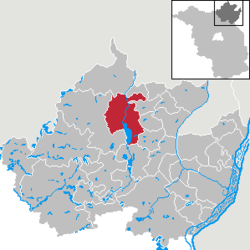 | ||
| Coordinates: 53°19′N 13°52′E / 53.317°N 13.867°ECoordinates: 53°19′N 13°52′E / 53.317°N 13.867°E | ||
| Country | Germany | |
| State | Brandenburg | |
| District | Uckermark | |
| Government | ||
| • Mayor | Hendrik Sommer | |
| Area | ||
| • Total | 142.18 km2 (54.90 sq mi) | |
| Population (2015-12-31)[1] | ||
| • Total | 19,275 | |
| • Density | 140/km2 (350/sq mi) | |
| Time zone | CET/CEST (UTC+1/+2) | |
| Postal codes | 17291 | |
| Dialling codes | 03984 | |
| Vehicle registration | UM | |
| Website | www.prenzlau.info | |
Prenzlau (formerly also Prenzlow) is a town in Brandenburg, Germany, the administrative seat of Uckermark District. It is also the centre of the historic Uckermark region.
Geography
The town is located on the Ucker river, about 100 km (62 mi) north of Berlin. Prenzlau station, opened in 1863, is a stop on the Angermünde–Stralsund railway line.
History
Settled since Neolithic times, the Prenzlau area from the 7th century AD was the site of several gords erected by the Polabian Slavs. In the late 12th century, the Dukes of Pomerania had the region colonized by Low German settlers.
Prenzlau itself, named after Slavic Premyslaw was first mentioned in 1187. It received town privileges by Duke Barnim I of Pomerania in 1234. When Duke Barnim signed the Treaty of Landin with the Ascanian margraves of Brandenburg in 1250, Prenzlau was already a fortified town with walls and moats, four parish churches and a monastery. Together with Berlin-Cölln, Frankfurt and Stendal, it ranked among the largest towns in the margraviate.
Prenzlau and the Uckermark region were devastated during the Thirty Years' War. From the late 17th century onwards French Huguenot refugees settled here and an economic recovery started. Also a garrison town, Prenzlau was again ravaged by passing troops during the Seven Years' War and the Napoleonic Wars. In the mid 19th century, several citizens emigrated to Australia, where they founded the town of Prenzlau, Queensland west of Brisbane.
In World War II the town centre was largely destroyed. The East German authorities had it rebuilt with large panel Plattenbau buildings.
Demography
 Development of Population since 1875 within the Current Boundaries (Blue Line: Population; Dotted Line: Comparison to Population Development of Brandenburg state; Grey Background: Time of Nazi rule; Red Background: Time of Communist rule)
Development of Population since 1875 within the Current Boundaries (Blue Line: Population; Dotted Line: Comparison to Population Development of Brandenburg state; Grey Background: Time of Nazi rule; Red Background: Time of Communist rule)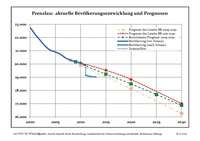 Recent Population Development (Blue Line) and Forecasts
Recent Population Development (Blue Line) and Forecasts
|
|
|
|
Politics
Seats in the town's assembly (Stadtverordnetenversammlung) as of 2104 local elections:
- Christian Democratic Union (CDU): 7
- Social Democratic Party of Germany (SPD): 7
- The Left: 6
- Bürgerfraktion (Independent): 4
- Wir Prenzlauer (Independent): 2
- Free Democratic Party (FDP): 1
- National Democratic Party of Germany (NPD): 1
International relations
Prenzlau has twinning relationships with:[3]
Notable people
- Christian Friedrich Schwan (1733–1815), publisher and bookseller
- Jacob Philipp Hackert (1737–1807), landscape painter
- Frederika Louisa of Hesse-Darmstadt (1751–1805), queen consort of Prussia
- Louis I, Grand Duke of Hesse (1753–1830)
- Princess Amalie of Hesse-Darmstadt (1754–1832)
- Princess Wilhelmina Louisa of Hesse-Darmstadt (1755–1776)
- Wilhelm Grabow (1802–1874), civil servant, judge, and politician
- Adolf Wilhelm Theodor Stahr (1805–1876), writer and literary historian
- Ernst Christian Friedrich Schering (1824–1889), apothecary and industrialist
- Johannes Schmidt (1843–1901), linguist
- Paul Hirsch (1868–1940), politician
- Hans Felix Husadel (1897–1964), composer and conductor
- Otto Kaiser (born 1924), scholar
- Brigitte Rohde (born 1954), sprinter
- Carola Zirzow (born 1954), sprint canoer
- Christiane Wartenberg (born 1956), athlete
- René Bielke (born 1962), ice hockey player
Photo gallery
 Gate Tower of the Brick Gothic 'Mitteltor'
Gate Tower of the Brick Gothic 'Mitteltor'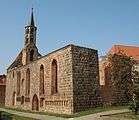 War memorial ruin of the Holy Spirit Church
War memorial ruin of the Holy Spirit Church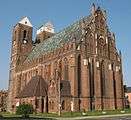 St. Mary's Church
St. Mary's Church Old townhall of Prenzlau
Old townhall of Prenzlau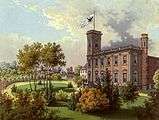 Historical painting of Dedelow castle, a part of Prenzlau
Historical painting of Dedelow castle, a part of Prenzlau- Dominican abbey of Prenzlau
- 'Unteruckersee' (Lower Ucker Lake) in Prenzlau
- Ucker canal watergate
- Platform of the train station
- Martin Luther memorial in Prenzlau
 Medieval city wall of Prenzlau, gate tower
Medieval city wall of Prenzlau, gate tower
References
- ↑ "Bevölkerung im Land Brandenburg nach amtsfreien Gemeinden, Ämtern und Gemeinden 31. Dezember 2015 (Fortgeschriebene amtliche Einwohnerzahlen auf Grundlage des Zensus 2011)". Amt für Statistik Berlin-Brandenburg (in German). 2016.
- ↑ Detailed data sources are to be found in the Wikimedia Commons.Population Projection Brandenburg at Wikimedia Commons
- ↑ A. Hilpert. "Partnerstädte der Stadt Prenzlau". www.prenzlau.eu (in German). Büroleiterin des Bürgermeisters, Geschäftsbereich Bürgermeister. Retrieved 2014-04-06.
External links
![]() Media related to Prenzlau at Wikimedia Commons
Media related to Prenzlau at Wikimedia Commons
- Municipal website (German)
